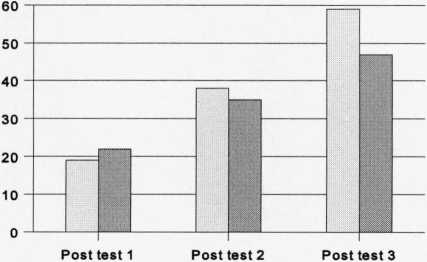Z=4.3, p<.0000; Z=3.1, p<.OO5). Also, the Definition and Lexical contrast groups provided
more “semantic” justifications than the Phonological control group (WilcoxomZ=4.4,
p<.0000; Z=2.9, p<.005).The Definition and Lexical contrast groups provided again more
“semantic” justifications than the Ostensive definition group (Wilcoxon: Z=4.1, p<.0000) and
(Wilcoxon: Z=2.5, p<.05).
Does children ,s provision of semantic justifications increase with increased exposure to the
lexical items?
A Friedman -Two -Way ANOVA was carried out. The children provided significantly more
“semantic” justifications over time (X2=I 2.3, df=2, p=.005). In addition, the same pattern was
evident for the Lexical contrast (X2=6.5, df=2, p=.05) and Definition group (X2=12.2, df=2,
p=.005).
Does the children's prior knowledge of the lexical items influence the provision of semantic
justifications?
As Figure 7.23 shows, during post test 1, the children tended to provide more “semantic”
justifications for the partially represented than the unknown words, while during post tests
2 and 3 they provided more “semantic” justifications for the unknown than the partially
represented words. However, the differences were not significant.
Figure 7.23 Provision of semantic justifications by children’s prior knowledge of the
lexical items across testing

I I Unknown words
I__I Partially represented words
244
More intriguing information
1. The name is absent2. The name is absent
3. Direct observations of the kinetics of migrating T-cells suggest active retention by endothelial cells with continual bidirectional migration
4. The name is absent
5. The name is absent
6. Poverty transition through targeted programme: the case of Bangladesh Poultry Model
7. The name is absent
8. Voting by Committees under Constraints
9. The name is absent
10. The name is absent